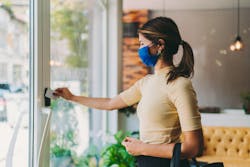Touchless Access Control Continues to Expand its Mission
As the world begins to reopen amid rapid vaccine distribution, business and organization leaders are tasked with earning back public trust and confidence by delivering safe, healthy and connected building environments. To keep up with the changes, businesses are rapidly adopting and integrating new, data-driven technologies into their existing facility infrastructures to meet evolving expectations and regulations. One of the most impactful solutions leading the way in this adoption wave is touchless access control.
Leveraging touchless technologies, facility touchpoints and occupant interactions can be optimized with powerful artificial intelligence (AI) and machine learning capabilities to deliver a streamlined building experience with minimal touchpoints. With these solutions visibly in place, occupants have peace of mind knowing that their health and wellbeing are protected, allowing them to remain productive and engaged. Connected, data-driven access control solutions create a modern, enhanced healthy building environment that will continue to exceed expectations and pay dividends long after the pandemic has passed.
The Evolution of Touchless Technologies in a Pre-Pandemic World
Despite their sudden rise in adoption, touchless technologies aren’t an overnight sensation; in the years leading up to the pandemic, demand for touchless technologies was already gaining steady momentum across many industries. Before the COVID-19 virus turned the world upside down, touchless access control existed as an easy way to improve and streamline security and the occupant experience, alleviating headaches attributed to traditional methods of access control.
From a security standpoint, touchless access control remedies common risks caused by human error. Employee identification badges can be easily lost, while keycodes in the wrong hands pose a dangerous cybersecurity risk. These physical methods of access control can also create opportunities for tailgating, allowing unauthorized personnel to enter buildings undetected. In addition, traditional access control forces individuals to stop at entryways or doorways to swipe their badge or input their keycode, creating traffic bottlenecks and a disjointed occupant experience that can be detrimental to customer and employee well-being.
Certain industries were ahead of the curve and had already led the way in touchless technology adoption pre-pandemic, particularly those that had to manage and track large volumes of ticketed individuals, such as airports and sports and entertainment venues quickly and efficiently. Hospitals had also adopted touchless access to minimize the spread of disease long before COVID-19 was on anyone’s radar, and the advanced degree of access control helped safeguard dangerous or vulnerable medical resources and medications like narcotics. Touchless technologies were clearly already positioned to become an industry-wide trend, but the COVID-19 pandemic and the resulting mindset accelerated that demand, turning a trend into a potentially life-saving necessity.
Touchless Access Control Continues to Gain Momentum as COVID-19 Wanes
The COVID-19 pandemic elevated touchless access as the gold standard for health and security. Suddenly, hospitals weren’t the only institutions concerned about touch contamination and occupant wellness. From banks to schools, every industry now faces a critical need for clean, healthy and safe building environments. Keypads and access badges became a hotspot for touch contamination, potentially leading to the spread of disease throughout any facility. At the same time, the bottlenecks caused by individuals stopping to swipe their ID or input their keycode was no longer just an annoying nuisance to busy employees and customers, but also an impediment to social distancing efforts. As a result, touchless access control rapidly evolved to keep up with demand, becoming a keystone technology for any facility’s security management and pandemic response strategy.
Utilizing the latest in AI-powered facial recognition technology, organizations can completely do away with access badges or keypads, greatly reducing the potential for touch contamination between individuals. By keeping occupants moving even when entering high-security areas, bottlenecks are mitigated, and security personnel can better monitor suspicious behavior as crowds are dispersed. Because every individual is automatically screened by facial recognition technology, security managers and occupants can rest easy knowing only authorized individuals are accessing the building.
In the COVID-19 era, touchless technologies have also grown to include health screening solutions that empower businesses to create and maintain healthy spaces to protect occupants. Elevated skin temperature screening solutions use thermal imaging software to identify individuals quickly and automatically with high temperatures, potentially indicative of fever or illness. Because the solution can screen large volumes of moving people at once, it removes the need for a manned temperature screening checkpoint, alleviating staffing burdens and allowing occupants to quickly and safely get where they need to go. To further prioritize occupant health, social distancing monitoring, contact tracing and mask detection technologies can be integrated to automatically monitor building occupants to ensure all individuals are adhering to safety guidelines.
These health screening and monitoring solutions can be integrated onto a single, cloud-based interface to provide security managers with comprehensive, data-driven and real-time insight into their buildings’ overall health status, even when offsite. Should an individual enter the facility with an elevated temperature, remove their mask or break social distancing rules, an alert is automatically sent to a security manager for swift remediation. This cloud-based remote monitoring capability empowers businesses to maintain a healthy, safe and connected environment at all times.
Delivering Optimal Outcomes in Myriad Vertical Markets
While touchless technologies were once considered an industry-specific tool, they are now considered an essential solution for any organization. They can optimize any building’s security strategy to provide data-driven protection, regardless of industry. By integrating these solutions into their existing network of building technologies, businesses and organizations can be empowered to drive the outcomes that matter most for their stakeholders, both during the pandemic and beyond.
- In a healthcare setting, patient arrival areas that can easily become crowded are particularly vulnerable to the spread of disease, and often require an individual to manually screen incoming patients and visitors for symptoms. Implementing elevated skin temperature screening solutions within lobbies or emergency areas streamlines the check-in process and removes the need for manual symptom screening, protecting doctors, nurses and staff in the process. An individual with a high temperature can be quickly navigated to a protected area, minimizing their time spent with healthy fellow patients or staff members without proper personal protective equipment (PPE).
- When airline tickets are replaced with facial recognition and retina scanning, airport security processes will be streamlined, allowing travelers to get where they need to go faster. This will have a positive effect on airports’ bottom lines: the quicker travelers get through security, the faster they are able to explore the airport’s dining and shopping opportunities, ultimately generating critical nonaeronautical revenue. By keeping security lines moving, airports will also ensure travelers are able to maintain social distancing guidelines to create a safe and healthy passenger experience without letting anything slip through the cracks at a security level.
- Within an office building, touchless access control allows employees to move throughout without worrying about the risk of infection found in traditional access control, allowing them to remain healthy and productive. Social distance monitoring tools can send employees real-time alerts through their mobile devices with mass notification systems if they violate social distancing protocol. Building administrators can also leverage mass notification tools to aid in contact tracing and redirecting foot traffic in case of a positive diagnosis. The investment in employees’ health, wellness and comfort can also improve employee satisfaction, enhancing workforce development and retainment efforts.
- In a school or college campus, traditional access control can place students and faculty at risk. Campus facilities like dormitories are particularly vulnerable to tailgating, and K-12 schools, unfortunately, face an increased threat of violent incidents. As a result, administrators need to know who is entering their facilities at all times, especially during the pandemic when social distancing and contact tracing are common practices. Facial recognition technology used in touchless access control gives them that real-time insight into their buildings’ comings and goings, providing an extra degree of protection at all times.
Across industries, organizations found their need for healthy, safe and connected building environments fiercely intensified by the pandemic. Through the strategic implementation of touchless technologies, any building can deliver streamlined occupant experiences that mitigate risk and surpass expectations.
Touchless Technologies Redefine the Modern, Healthy Building
As the world adapted to the pandemic over the last year, occupants’ expectations have rapidly evolved; whether they are an employee, patient, customer or visitor, they expect the spaces and places they spend time in to demonstrably invest in their health and wellbeing while maintaining an enjoyable experience. Even with vaccines being distributed around the world, the public’s new, heightened awareness of health and safety risks means this desire for an optimized building environment is unlikely to fade.
It’s up to business owners and security managers to rise to this challenge and reinstate confidence by leveraging intelligent and connected touchless solutions. By integrating touchless technologies like biometric access control, elevated skin temperature screening solutions, face mask detection and social distance monitoring solutions, organizations can not only navigate today’s challenges and meet consumer demand but future-proof their facilities as well. The resulting facility connects every data touchpoint to create a modern environment that is healthy, safe and ready for anything.
About the author: Tony McGraw serves as vice president and general manager of security solutions at Johnson Controls, a global leader for smart, healthy and sustainable buildings. He brings more than two decades of leadership in security and operations to his current role in helping realize safer and healthier buildings to improve customer and occupant experience.
About the Author

Tony McGraw
vice president and general manager of security solutions at Johnson Controls
Tony McGraw serves as vice president and general manager of security solutions at Johnson Controls, a global leader for smart, healthy and sustainable buildings. He brings more than two decades of leadership in security and operations to his current role in helping realize safer and healthier buildings to improve customer and occupant experience.
